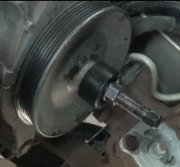Hi,
If you are hearing noise, either the pump is bad or there is air in the system. I'm not sure if you bled the new pump. Here are the directions. It requires specialized tooling to do. The attached pics correlate with the directions.
________________________________
2015 Jeep Truck Wrangler V6-3.6L
Power Steering System Bleeding
Power Steering System Bleeding
POWER STEERING SYSTEM BLEEDING
STANDARD PROCEDURE - POWER STEERING SYSTEM BLEEDING
Special Tools
Pic 1
9688A - Cap Adapter, Power Steering Pump
Originally Shipped In Kit Number(s) 10075A-DOD, 10075-CHRYSLER, 10075-DODGE.
C-4207-A - Vacuum Pump, Hand
WARNING:
Fluid level should be checked with the engine OFF to prevent personal injury from moving parts and to assure an accurate fluid level reading.
CAUTION:
Mopar Power Steering Fluid + 4 or Mopar ATF+4 Automatic Transmission Fluid is to be used in the power steering system. Both Fluids have the same material standard specifications (MS-9602). No other power steering or automatic transmission fluid is to be used in the system. Damage may result to the power steering pump and system if another fluid is used. Do not overfill the system.
CAUTION:
If the air is not purged from the power steering system correctly, pump failure could result.
NOTE:
Be sure the vacuum tool used in the following procedure is clean and free of any fluids.
Pic 2
Check the fluid level. The power steering fluid level can be viewed through the side of the power steering fluid reservoir. Compare the fluid level to the markings on the side of the reservoir. When the fluid is at normal ambient temperature, approximately 21° - 27° C (70° - 80° F), the fluid level should read between the MAX and MIN markings. When the fluid is hot, fluid level is allowed to read up to the MAX line.
CAUTION:
Do not fill fluid beyond the MAX mark. Check cap seal for damage and replace if needed.
Remove the cap from the fluid reservoir and fill the power steering fluid reservoir up to the MAX marking with Mopar Power Steering Fluid + 4 or Mopar ATF+4 Automatic Transmission Fluid.
Tightly insert Power Steering Cap Adapter (4), Special Tool 9688A, into the mouth of the reservoir (3).
CAUTION:
Failure to use a vacuum pump reservoir (1) may allow power steering fluid to be sucked into the hand vacuum pump.
Attach Hand Vacuum Pump (2), Special Tool C-4207-A or equivalent, with reservoir (1) attached, to the Power Steering Cap Adapter (4).
CAUTION:
Do not run the vehicle while vacuum is applied to the power steering system. Damage to the power steering pump can occur.
NOTE:
When performing the following step make sure the vacuum level is maintained during the entire time period.
Using Hand Vacuum Pump (2), apply 68-85 kPa (20-25 in. Hg) of vacuum to the system for a minimum of three minutes.
Slowly release the vacuum and remove the special tools.
Adjust the fluid level as necessary. Refer to Step #1.
Repeat Step #1 through Step #7 until the fluid no longer drops when vacuum is applied.
Start the engine and cycle the steering wheel lock-to-lock three times.
NOTE:
Do not hold the steering wheel at the stops.
Stop the engine and check for leaks at all connections.
Check for any signs of air in the reservoir and check the fluid level. If air is present, repeat the procedure as necessary.
_____________________________
Let me know if that was done. Also, let me know if you are purchasing a new or re-manufactured pump. If it is a re-manufactured pump, try a different brand. I have see many of these with issues.
Let me know.
Joe
Images (Click to make bigger)
Friday, February 28th, 2020 AT 8:46 PM




